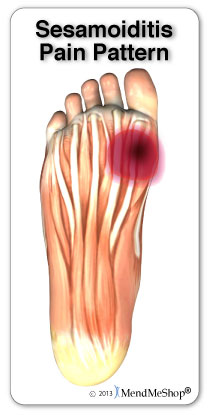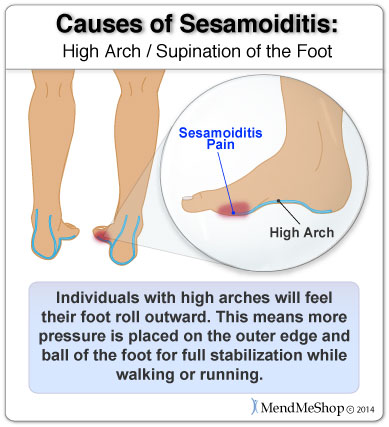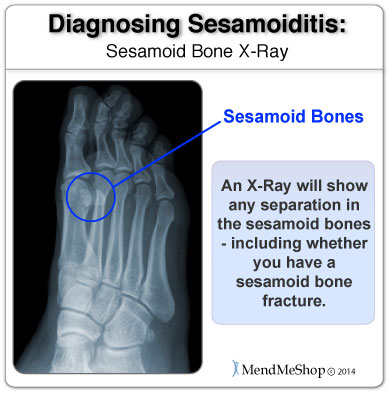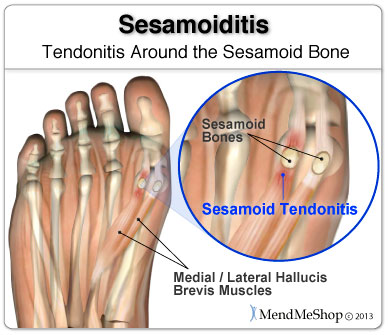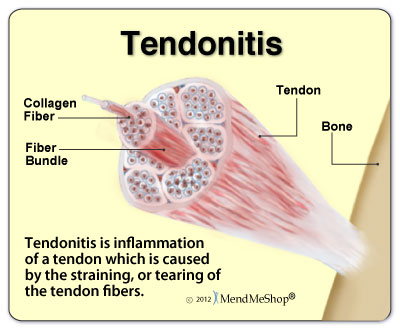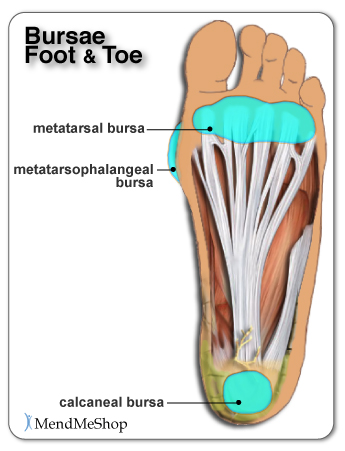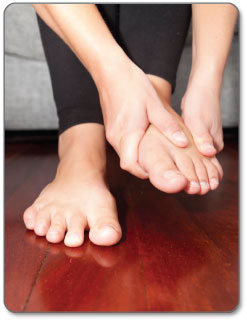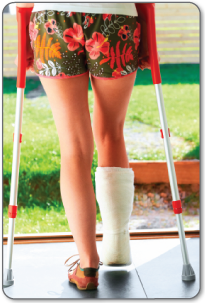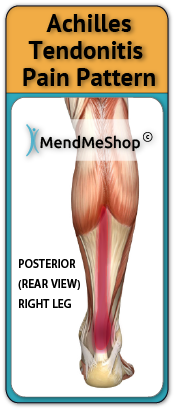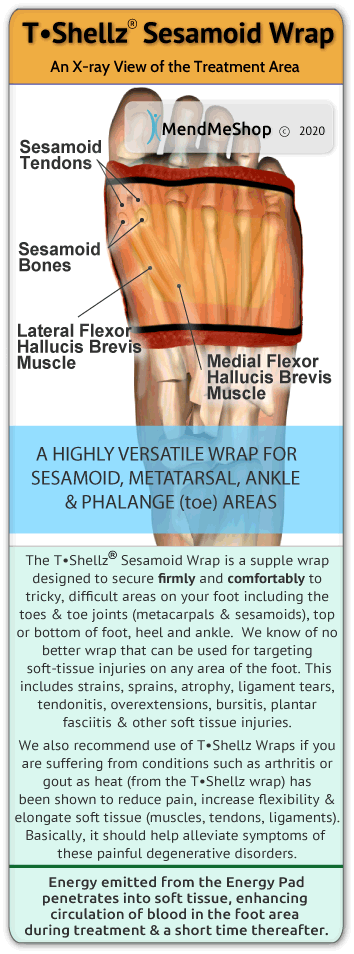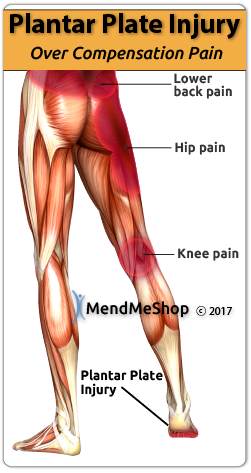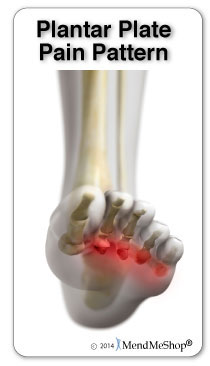|
More Tendon Facts:
Tenosynovitis is a condition affecting the sheath that surrounds a tendon. In many cases, the sheath encounters tearing due to inflammation of the underlying tendon. The majority of tenosynovitis sufferers are female.
A fully ruptured Tendon REQUIRES surgery. It will not heal on its own.
Except for a fully ruptured tendon, Tendonitis can almost always be cured without surgery.
Left untreated, tendonitis can be extremely debilitating and lead to life long complications.
Continually using your Tendon while it is injured will lead to a worse injury.
To Heal as fast as possible use conservative treatment options at home such as: Rest
Use an Ice Pack to Get Swelling Down
Use a TShellz Wrap at Home Once Swelling is Down
Stretch at Home Once Your PT or Doctor Approves
Treat the Injury Well Beyond the Point After the Pain Disappears
|
Causes, Diagnosis and Treatments for Sesamoiditis & Sesamoid Tendinitis
What is Sesamoiditis?
Sesamoiditis is a general medical term used to describe any kind of injury that causes irritation in and around the sesamoid bones. This includes tendonitis (inflammation in the tendon tissue) surrounding the sesamoid bones and any kind of fracture or damage to the bone as well. Sesamoiditis may cause pain and inflammation in the sesamoid tendons that surround the sesamoid bones. This inflammation can spread further into more tendons and ligaments of the ball of the foot if not dealt with quickly.

Overall, this condition will make it extremely painful to walk, as fresh waves of pain can be felt every time the big toe moves or is stressed while walking or doing any other sort of activity. To reduce pressure on the big toe while walking, most people will try to walk while applying their weight only on the heel of their foot and turn the affected leg out to one side - creating a shuffling / limping type of movement.
Long-term changes in your gait (the way you walk) - such as shuffling to reduce pain on the ball of your foot - can impact other areas of your body and possibly result in something called 'over compensation pain'.
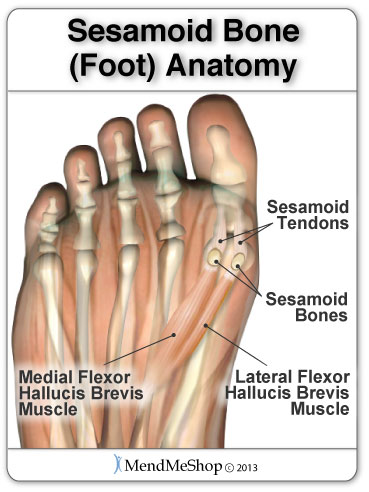
What Is Over Compensation Pain?
Everything in the human body is connected. Any sesamoiditis injury can lead to other injuries over time if not treated properly. You might start shuffling on the heel of your injured foot and place more weight on your opposite, healthy foot. Shuffling your way around for a long period of time may lead to pain in the heel of your foot, knee, hip or lower back on your injured side because you are mis-aligning your entire leg (keeping it straight and off to the side) to compensate for the injury.
Symptoms of Sesamoiditis
If you have sesamoiditis you may experience:
- Pain that will come and go in the ball of the foot just beneath your big toe joint.
- A gradual onset of pain over time if you're still continuing on with the activity that has caused and/or worsens this condition.
- There may not be a visible sign that you even have sesamoiditis - swelling of the ball of the foot and bruising may or may not be present.
- Pain that increases when your big toe is stretched up (when your toes push off at the end of a step).
- Limited range of motion in your big toe, especially when straightening it out.
- Moderate or severe cases of sesamoiditis may result in a catching or popping of the big toe followed by increased pain.
- Most people with sesamoiditis may notice the pain decrease as soon as the activity that caused the injury is reduced or stopped.
- You're suffering from pain with no clear sign of an injury (no redness under your foot, bruising or swelling).
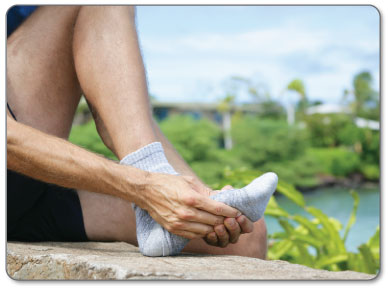 If any of those statements are true for you or you're suffering from on-going pain under your big toe or at the front of your foot then you might have an injury called "Sesamoiditis". It's an injury that's not commonly heard - people are more likely to understand that they might have plantar fasciitis, tendonitis or some other injury in their foot.
If you have it, you know that sesamoiditis is a very painful injury affecting the soft tissue and bone in the ball of your foot. It happens mostly to those who regularly puts significant, recurring pressure on the front of their foot.
Sesamoiditis is one of those injuries that can really bring down the quality of your life. Anyone - young or old - can suffer from this injury, and if you're active this condition will keep you from doing the things you love to do. It will even start interrupting any of your normal daily tasks and make living life harder than it really needs to be.
What Causes Sesamoiditis?
Sesamoiditis can happen when you increase the pressure on the ball of your foot in activities like running, playing basketball, football, golf, tennis, taking a step class or ballet lessons. In activities like running, more than half of our weight-bearing travels through our big toe and sesamoid bones (reference: 1).
Any changes to the structure of your foot can also lead to sesamoiditis. This would include if you already have high arches, wear high-heeled shoes regularly, wear a new pair of shoes that don't give your toes enough room, naturally run or walk on the balls of your feet or have bony feet without enough fat to cushion your sesamoid bones.
Sesamoiditis is an overuse injury caused by the same toe movements that are performed over and over again.
Sesamoiditis Diagnosis
The best way to diagnose this condition is with a quick visit to the your doctor for a physical examination of your foot. The doctor will be looking for tenderness at the sesamoid bones just below your big toe.
Are you having trouble bending and straightening your toe?
Range of motion movements / tests, will be done to see how much movement has been lost in the toe. Your foot might hurt from the doctor poking and prodding at it, but by doing this the doctor will know for sure the source of your pain, the level of tenderness in and around your sesamoids and how well your toe can move with this condition.
Your doctor may also consider any previous foot injuries or joint stiffness that you may have had in the past. This will help the doctor to determine if you have a more complex injury in your foot and rule out any other foot injuries that may be present.
An x-ray of the foot will ensure proper diagnosis, sometimes they will x-ray both feet looking for similarities in bone structure when comparing both of your feet. This x-ray will show your sesamoid bones and whether there is any separation in each bone. For approximately 10 to 30% of people the sesamoid bone closer to the middle of the foot (the medial sesamoid) will be naturally divided into 2 or more pieces (reference: 1, 2, 3).
The doctor will have to find out if you naturally have a divided sesamoid bone OR if you have a fracture in this bone. If you do have any evidence of separation it's likely your doctor will have to perform more tests to find out for sure if you have a fracture in these bones.
Usually if the x-ray shows the bone is jagged there may be a fracture in the sesamoid bone, and if the separation is smooth then this means you have a naturally separated sesamoid bone.
Other tests like a bone scan, MRI (magnetic resonance imaging) or blood tests may be done if an x-ray looks normal or the doctor is unsure whether you have a fracture or natural separation in your sesamoid. These tests will also rule out any infections of the bone or tissue and help to determine if you are suffering from other injuries around your sesamoids - like arthritis or gout.
If you have a Sesamoid Injury, it's important to heal it quickly and completely. If you don't, it may plague you for years and cause more debilitating injuries due to over-compensation.
What are Sesamoid Bones?
A 'sesamoid' bone is a bone that's not connected to any other bone. Sesamoids are connected to tendons or embedded in muscles. We have many sesamoids in the body - your knee cap being the largest sesamoid bone. They are also found in our hands and feet, and the sesamoid bones in the foot are where the most common sesamoiditis problems occur.
Sesamoids in the foot have three jobs, first they help the big toe move (providing a smooth surface for the tendons controlling your big toe to move) . Second, they provide you the leverage your need when you 'push off' with your foot (they act like pulleys helping to move other tissue that control your big toe). And third, they absorb the weight placed on the ball of your foot when you walk, run or jump.
Do You Really have Sesamoiditis?
Our feet are one of the most complicated joints in our bodies with 26 bones, 33 joints and more than 100 tendons, muscles and ligaments (reference: 1).
Big toe pain can be from injuries to the sesamoid bones or the soft tissue in the foot, some of the more common injuries being:
- Foot bursitis - Bursitis can occur in the toe joints, the side of the foot, the heel and around the ankle. As we walk, run or jump, the ground surface and the shoes we wear play an important role in how much trauma our feet experience. Every step can cause a small amount of damage to a particular area in the foot which can increase the risk of bursitis.
- Morton's neuroma - This condition usually causes burning pain in the ball of the foot that may radiate into the toes. The pain generally intensifies with activity or wearing shoes. You may sometimes feel that you are "walking on a marble," and you have persistent pain in the ball of your foot. You may also have numbness in the toes.
- Metatarsalgia - This condition can also cause pain in the ball of your foot, that area between your arch and the toes. Metatarsalgia is a common over-use injury, persistent stress can lead to chronic irritation and inflammation of the bone covering and surrounding tissues, such as ligaments and tendons.
- Plantar Fasciitis - Pain associated with plantar fasciitis normally starts as a dull ache and then progresses to a sharp, knife-like pain or constant throbbing feeling that is worse when you put weight on your foot. The most tender areas tend to be in the center of your heel and along the inside and bottom of your foot towards your toes, where your heel and arch meet.
- Turf toe - This can happen when the big toe joint is pushed beyond its' normal range (backwards or downwards). A 'pop' is felt at the moment the injury happens followed by sharp immediate pain. Symptoms include swelling in the foot, the entire big toe joint is affected and limits the motion in the toe.
What's the Difference Between:
Sesamoid Tendonitis, a Sesamoid Bone Fracture
vs Other Sesamoiditis Pain?
What is Sesamoid Tendonitis
Sesamoid tendonitis (sometimes spelled tendinitis and pronounced 'tendinitus') is irritation and/or inflammation of the tendons surrounding the sesamoid bones. You will feel this irritation and/or inflammation when there is a strain, damage or micro-tearing in the tendon tissue.
Anyone can suffer from sesamoid tendinitis - for younger people it usually happens from repetitive movement of the toe in athletic activities like baseball and ballet. In adults, this injury can happen from over-use OR degeneration of the tissue as we age.
You could have different types of sesamoid tendonitis including:
- Tendinosis - a condition caused by chronic degeneration (wearing away) of the tendon fibers over time.
- Tendinopathy - chronic inflammation of the sesamoid tendon(s) that results from many small tears over from from over-use or repetitive movements.
- Tenosynovitis - damage or micro-tearing to the sheath covering the sesamoid tendon(s).
It's possible to have tendonitis / tendinosis / tendinopathy AND tenosynovitis at the same time, creating a more complicated sesamoid tendon injury. In all these cases, however, you can treat these very effectively at home with a Sesamoid/Wrist Cold Compress or Ice Pack and Sesamoid/Wrist TShellz Wrap®.
The Sesamoid/Wrist TShellz Wrap® is a specialized treatment that will accelerate bloodflow (and therefore the rate of healing) both in the tendon sheath and the damaged tendon itself. This increased elasticity and flexibility of the tendon, thus helping to break the re-injury cycle common in chronic tendonitis cases. Chronic sesamoiditis is very real. The TShellz Wrap® will help get rid of it, as long as you are willing to treat yourself every single day.
What is a Sesamoid Bone Fracture
A sesamoid bone fracture causes many of the same symptoms as sesamoid tendonitis - with pain, irritation and/or inflammation in the ball of the foot. Unlike sesamoid tendonitis, an acute or traumatic sesamoid bone fracture can result in a lot of swelling in the front of your foot and possibly a bruise under the big toe. Your doctor will be able to tell if you have a sesamoid bone fracture by performing an x-ray.
There are 2 types of sesamoid bone fractures:
- Acute ("Regular") Fracture - is caused by a direct blow or impact to the bone - like landing heavily on your feet from a fall / jump. An acute sesamoid fracture produces immediate pain and swelling at the site of the break, but usually does not affect the entire big toe joint.
With a "regular" fracture the entire material of bone, including the outer lining of the bone (sometimes called the 'cortical') will crack. This fracture can be straight, diagonal, jagged, in several pieces, etc.
- Chronic ("Stress") Fracture - is a hairline break usually caused by repetitive stress or overuse - like running regularly or jumping up and down from platforms all day. A chronic sesamoid fracture produces longstanding pain in the ball of the foot beneath the big toe joint. The pain, which tends to come and go, generally is aggravated with activity and relieved with rest.
With a "stress" fracture the outer lining of the bone will be fine, but the inside of the bone will have hairline fractures (sometimes on a microscopic level).
"Stress" or chronic fractures usually take much longer to heal because they will often remain in a long-term state of non-healing. Treatment for both kinds of sesamoid bone fractures is basically the same as treatment for sesamoid tendonitis.
What if I Don't Have Tendonitis or a Fracture?
There are 3 more injuries that can happen in or around your sesamoid bones resulting in sesamoiditis pain:
- Intractable Plantar Keratosis (IPK) - this is like a callus or corn that's formed on the ball of your foot under your big toe that can cause sesamoiditis-like pain. Over time this callus / corn can develop into a larger lesion with a very painful sore-spot in the center.
If left untreated, this condition can lead to a more serious sesamoiditis injury, reduce range of motion / mobility of your foot and change the way you walk on your foot. Conservative treatment methods are used to treat this injury. Surgery is only ever recommended if you continue to feel pain and have reduced range of motion even after using conservative treatment methods.
![Sesamoiditis can sometimes involve a break or fracture to your sesamoid bone.]() - Osteochondritis (Avascular Necrosis) of the Sesamoid Bone(s) - This is a condition where blood supply to 1 or both of your sesamoid bones isn't available. Over time reduced blood flow to your sesamoid bone can actually cause a portion of your bone to die (this is also called 'necrosis'). Your body will try to heal this injury by building up extra calcium (bone) around the dead spot.
This can sometimes happen if you've suffered from a chronic ("stress") fracture in your sesamoid bone that hasn't healed properly. In most cases conservative treatment methods won't work to treat this condition and surgery will be needed to remove the sesamoid bone (reference: 1, 2). If surgery is required, conservative treatment methods can then be used during post-surgery rehabilitation.
 - Nerve Entrapment - There is a major nerve that runs near our big toe and second toe called the 'Medial Plantar Nerve'. Even though this nerve is usually not close to the sesamoid bones, nerves can sometimes naturally be in areas where doctors don't expect them to be. It's possible to be suffering from sesamoid pain, with the pain really coming from your medial plantar nerve if it's running under one of your sesamoid bones. If you've had an x-ray and multiple tests done to see if you have sesamoiditis or a sesamoid bone fracture and there is no definite result, you might be suffering from nerve entrapment in that area.
Your doctor can see if you have nerve entrapment in this area by doing a test called 'Tinel's Sign'. During this test the doctor will lightly tap near the painful area to see if you feel any tingling or 'pins and needles' sensations. If you feel tingling that runs down your big toe, you might be suffering from nerve entrapment (reference: https://www.hmpgloballearningnetwork.com/site/podiatry/blogged/can-sesamoiditis-and-hallux-valgus-be-nerve-entrapment Jan 2023).
- Sesamoid Arthritis - Sometimes you may have cartilage damage under your sesamoid bones between your sesamoids and the bones in your toes. This cartilage damage can lead to arthritis, a painful inflammatory condition causing stiffness and swelling in your joints. You could have sesamoid pain that is really a case of arthritis under your sesamoid bones. Any signs of arthritis around your sesamoid bones should show up in an x-ray.
How Do I Cure Sesamoiditis -
What You Can Do!
If you suspect you have sesamoiditis,
- Usually conservative treatment methods are all that's needed to treat sesamoiditis, surgery is only ever used if long-term conservative treatment methods don't work or if you've suffered from a stubborn stress (chronic) sesamoid bone fracture. Conservative treatment options for sesamoiditis typically includes rest, icing of the injury, avoiding activities that cause or worsen the pain that you're feeling, wearing comfortable shoes that keep your big toe straight and anti-inflammatory over-the-counter medication
(reference: 1. https://orthoinfo.aaos.org/en/diseases--conditions/sesamoiditis, 2. http://foot.com/site/foot-conditions/sesamoiditis, 3. http://www.healthcommunities.com/sesamoiditis/treatment.shtml, 4. http://www.ahni.com/Specialties/Foot+and+Ankle/Articles/Common+Disorders/Sesamoiditis.html, 5. http://www.methodistorthopedics.com/sesamoid-problems)
- Second, if your doctor has decided that your injury can be treated with conservative treatment options, then you'll find that many of our customers have had great success treating themselves with our powerful conservative treatment products - the Cold Compress or Ice Pack and TShellz Wrap®.
- Or, if surgical intervention is required, talk with your doctor about using these same products for post-surgery recovery as you'll find them to be effective for reducing post-surgery inflammation, enhancing range of motion and reducing scar tissue growth. Keep in mind that the TShellz Wrap® should only be used a minimum of 6 weeks after surgery and once you have been assigned home stretching from your doctor or PT - basically not until at least 6 weeks after surgery)
No one is immune to sesamoiditis or tendonitis, but you can easily reduce your risk of further injury with consistent conservative treatments
The good news is that most cases of sesamoiditis can be cured using conservative treatments. In most cases, surgery is not needed!
It's generally understood by doctors and surgeons, that surgery will introduce more scar tissue into the foot. This added scar tissue will be problematic, requiring visits to the clinic and conservative treatment options post-surgery. When it comes to sesamoiditis and bone fractures there's only a few surgical options for treatment - removal of the sesamoid bone(s), scraping of the sesamoid bone(s) or a bone graft. This is why surgery is only performed as a last resort for chronic sesamoiditis injuries or a fractured bone that won't heal with conservative treatment methods.
Some conservative treatment methods recommended include:
- Rest - This is important for initial recovery; rest and elevation will help reduce pain, swelling and inflammation in the early stages of injury. This can be difficult when you have to carry on with daily activities, but resting and elevating your foot whenever you can is recommended. During your recovery you will probably have to modify or avoid the activities that put stress on your sesamoids until your pain and inflammation settles.
- Avoid Activities that Caused Your Hip Injury - While resting your foot it's also important to avoid all activities that may have caused your sesamoiditis (especially any repetitive toe or foot movement). Continuing on with regular activities will not only make your injury worse, but limping / shuffling just to get by can also wind up giving you over compensation pain in other areas of your body.
- Use a Cold Compress or Ice Pack - Cold is very effective at reducing pain and inflammation - use at the onset of the injury and during flareups.
- Use a Sesamoid TShellz Wrap® (a Circulatory Boost device) - Once swelling has been reduced, you can use your own blood flow to maximize your rehabilitation by reducing your recovery time and reducing your risk of reinjury. Improved blood flow to the toes and the ball of your foot in most cases will help improve recovery time while improving overall health of tissue in the area. Promoting blood flow to the injury will help to minimize the growth of scar tissue, increase flexibility and help prevent atrophy. This is why we recommend TShellz Wrap before undergoing activity - an increase in flexibility should help reduce risk of further injury while also assisting in the battle against atrophy.
- Wear Low-Heeled Shoes with Less Arch Support, Flat Insoles, and/or a Soft-Sole - Wearing a stiff-soled shoe (like clogs) with less arch support, or flat insoles that keep your big toe straight, can help to reduce the pressure being placed in your sesamoid bones. For some people, a soft-soled shoe (like flip-flops) are even more comfortable and reduce the pain. If you've recently started wearing a new pair of shoes with a different type of arch support insole then this might even be the reason why you now have sesamoid pain. Many doctors will advise their patients to wear stiff-soled shoes as a conservative treatment method to heal sesamoiditis before even considering surgery (reference: 1, 2).
- Put Orthotics in Your Shoes - Use of any kind of orthotic or insert for added support in your shoe should always be done through the recommendation of your doctor. There are certain shapes of padded inserts / orthotics that are designed to relieve pressure on the sesamoids and keep the big toe straight. You have to be careful with your choice of orthotic and may need to get some custom-made by your doctor because there's always a possibility that using the wrong orthotic will make your injury worse.
- Tape Your Big Toe - You can try taping or strapping your toe in a flexed position (bent down) to reduce any pressure placed on your sesamoid bones (reference: 1).
- Immobilize Your Foot with a Cast for a Few Weeks - If you're suffering from a fracture of your sesamoid bone that has the potential to heal on its own then your doctor might suggest casting your foot in order to avoid surgical removal of your sesamoid. Usually the doctor will have you wear the cast for about 6 weeks and advise you to wear stiff-soled shoes after you're out of the cast (reference: 1). Whether your doctor will recommend casting totally depends on their preference - some doctors prefer not to cast and will recommend surgery right away.
Restricted Movement Is Risky If It Goes On For Too Long
For acute (new or recent) Achilles tendon tears that have the ability to heal on their own - your doctor may even cast your foot in a toe pointed position (in something called a "hanging enquinus cast") or in a removable brace/splint. A removable splint can be very helpful to prepare you for PT sessions and mobility exercises.
Prolonged use of a cast, removable splint, or long-term rest (restricted movement) without proper exercise or stretching can make your Achilles tendon injury worse. If your Achilles tendon remains completely immobilized and at constant rest, the ends of the Achilles tendon (where it attaches to bone or other muscles) will begin to fill in with scar tissue as part of the healing process. You may also have on-going symptoms of pain, swelling and inflammation, and even poor blood flow circulation.
Lack of proper blood flow and growth of scar tissue will decrease the natural length of the tendon (atrophy) and tighten tissue, reducing the flexibility between your ankle and foot. Your ability to push off with your foot in certain activities such as running, jumping, or going up and down stairs all become compromised. You are also at an increased risk of re-rupture of the tendon, especially if the initial injury was large and required surgery in the first place.
If You Want to Effectively Treat Sesamoiditis With Top Conservative Treatments, This is How You Do It
Step 1 - Reduce Pain & Swelling with Cold Compression
The 1st step for getting rid of sesamoiditis is to reduce the swelling. This is a necessary step that will also probably get eliminate most of the pain. This is due to in part to the compression but also the cold, slowing down the nerve and tissue function... Once swelling is reduced, your blood vessels are no longer blocked and the healing can begin. This is why for years doctors, trainers and other medical professional have recommended RICE (Rest, Ice, Compression, Elevation) to treat the pain and swelling of fresh injuries, chronic pain, and after any re-injury.
Use a Cold Compress or Ice Pack:
- 24 to 72 hours after your initial injury or when you first notice pain and swelling in the ball of your foot to stop tissue damage at the microscopic level, relieve pain, and decrease swelling.
- After exercise, workouts or activity of any kind to prevent re-injury of your sesamoids.
- Before and after surgery during rehabilitation to control pre and post-surgery pain and swelling.
- Anytime you feel your sesamoiditis has made your foot tender, painful or you're having a flare-up of an old sesamoiditis injury.
- Anytime you have swelling, sharp throbbing pain or inflammation in the ball of your foot.
- Any other situation where you need to draw the pain and inflammation out of your foot.
Step 2 - Improve Circulation, Soften Scar Tissue & Prevent Re-Injury with TShellz Wrap®
After the inflammation in your foot has been reduced, providing extra blood flow and strengthening the tissue around your sesamoid bones is recommended.
Promoting blood flow within a muscle or soft tissue injury to help the body heal itself is a concept that has been utilized for centuries. This is where the focus has to be if you are seeking long-term improvement.
Oxygen and nutrients, carried within the blood, are critical for the body to heal itself. Without proper blood flow, recovering from an injury or condition will be delayed...sometimes for a very long period of time.
Incorporating a Sesamoid TShellz Wrap® into your home conservative treatment routine is our recommended way to enhance blood flow in the treatment area (during the time of treatment and for a short duration afterward). Blood flow is how the body heals soft tissue, and when there is low blood flow (as is the case with inactive joints due to pain), your body cannot achieve a good rate of healing. Enhancing localized blood flow is really a way to ensure that you are maximizing your body's healing rate.
It is through the blood the body carries the nutrients and oxygen that injured tissues rely on for recovery.. It is well known that increased blood flow helps your body accelerate the healing process.
This is why the TShellz Wrap® is such an important tool. The whole purpose of the wrap is to accelerate blood flow to soft tissue in the treatment area. The end result; you relax the blood vessels within soft tissues of the treatment area. The vessels will naturally expand and allow for more blood flow to reach the very tissues you are trying to heal. In addition, this process will help clear the area of toxins and excess fluid build up, thereby reducing inflammation.
As a side benefit, the TShellz Wrap® also emits heat, which is known to increase flexibility as well as elongate tissue. This is why we recommend the use of the TShellz Wrap® before undergoing activity that could cause significant stress on the area in question - if tissue is more flexible it is less likely to dstrain further, thus reducing your risk of incurring further injury. The less re-injury that occurs, the faster your recovery will be.
With regular use of the
TShellz Wrap:
- Your pain will be reduced.
- Due to increased blood flow, soft tissue in the area will recover at an accelerated rate.
- Due to increased warmth in soft tissue, the corresponding joint will have a larger range of motion and increased extensibility of collagen tissue. This should translate into a reduced rate of re-injury occurrance as soft tissue becomes more flexible.
(Chapter 9 of "Therapeutic Heat and Cold", 4th edition.
(amazon.com link - Ed. Justus F. Lehmann, M.D., Williams, and Wilkin)
Attach the TShellz Wrap®, plug it in and let the Energy Pad do the work!
Use a TShellz Wrap:
- After swelling and inflammation have been reduced with cold compression.
- Before exercise or workouts to warm up your foot & prevent re-injury.
- Before and after surgery during rehabilitation to warm up your tissues before exercising or stretching.
- Anytime you feel the area in and around your injury has stiffened up, is tight and your mobility is reduced.
- Anytime you have sore or aching tissue.
- Any other situation where you need to increase blood flow to your injury to relax your tendons, ligaments & muscle, prevent re-injury and enhance flexibility of your tissue.
Questions about using Circulatory Boost For Your Sesamoiditis, Plantar Fasciitis or Plantar Plate Tear?
Call one of our
AidYourTendon Advisers at no cost or obligation to address any lingering questions you have about stimulating blood flow in your foot.
All it takes is one call - 1-866-237-9608
Product Advisors are available 9:00 am to 5:00 pm Eastern Standard Time Monday to Friday.
Learn More About Tendon Injuries & TreatmentsI want to learn more about Post-Surgery Recovery I want to learn more about TShellz Wrap® Circulatory Boost I want to learn more about Ice & Heat: Which Is Better For Treatment? I want to learn more about Tendonitis Treatments I want to learn more about Tendonitis Surgery
FREE SHIPPING ON ALL PRODUCTS CURRENTLY ENABLED
60 DAY TRIAL PERIOD
During your recovery, you will probably have to modify and/or eliminate any activities that cause pain or discomfort at the location of your soft tissue injury until the pain and inflammation settle. The more diligent you are with your treatment and rehabilitation, the faster you will see successful results!
|
Tendon Injury Facts:
When the tendon gets inflamed it is known as tendonitis, and when the tendons are chronically overused, it may lead to microscopic tears in the collagen matrix and causes a gradual weakening of the tissues.
Achilles tendonitis is a common injury among runners, as the Achilles tendon is responsible for helping you lift off the ground with each stride.
As computers become ever more important elements of the work place and everyday life, incidents of wrist tendonitis are on the rise.
Oral Medications can mask the pain but do not aid in the healing of tendonitis. Anti-inflammatories and pain killers can mask the pain and indirectly cause tendonitis to worsen.
Ice and Compression treatments are the easiest and most effective treatments for tendonitis.

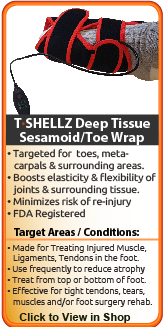







|

